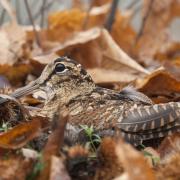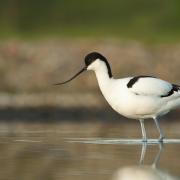Love them or hate them, jellyfish are fast becoming a common sight along Dorset’s beaches in the summer, but as Sally Welbourn explains, they are something to be admired not feared

Whilst many shudder at the thought of encountering a jellyfish, there is far more to these mysterious creatures than meets the eye. Emma Rance, Dorset Wildlife Trust (DWT) Marine Conservation Officer, has seen first hand the rapidly increasing numbers in our local waters.
“In my 11 years with Dorset Wildlife Trust, I’ve never seen so many barrel jellyfish as we’ve had over the last two years,” she says. “Any onshore winds will cause them to wash up on the beach, but recent sightings also coincided with the ‘spring algal bloom’ – this is an explosion in microscopic plankton as sea temperatures rise and sunlight increases which in turn kick-starts the food-chain in the sea.”
Emma says that recent research reveals that the barrel jellyfish we are seeing now are not this year’s juveniles, but from last year’s populations. “We have seen evidence in the Irish Sea that these species are ‘over wintering’ in the safety of deep water. I suspect the same thing is happening in Dorset, allowing them to make the most of the prey-rich waters in the spring.”
Jellyfish have received some bad press over the years, and in some countries their sting can be deadly. And whilst we do occasionally seen the Portuguese Man O’ War in UK waters, a jelly fish renowned for having a potentially deadly sting, this fearsome reputation has been wrongly applied to the jellyfish species commonly found around the British Isles.
“All jellyfish have microscopic stinging cells along their tentacles, but not all of those can penetrate skin,” explains Emma. “For example, with the barrel jellyfish, the majority of people would receive a mild sting compared to others who may not even get stung. Though we would never advise someone to touch a jellyfish – even a stranded one, the actual risk to humans is low. In the south-west the jellyfish with the most painful sting is the lion’s mane jellyfish – which is less common here than it is further north.”
In fact, the jellyfish’s sting is vital for their survival. “Jellyfish have a pretty basic ability to catch food, they drift until the prey passes and then they fire out microscopic stinging harpoons,” says Emma. “Once the prey is paralysed, the food is slowly absorbed and passed up the tentacles into the digestive system. As jellyfish can’t swim away quickly, their sting might also be effective as a defence mechanism. Some fish species even take advantage of this and will swim around the jellyfish as juveniles to protect themselves from predators.”
The most common jellyfish species in UK waters are the moon and compass jellyfish. These are smaller than the barrel jellyfish, but quite distinctive and colourful. The moon jellyfish’s stomach glows orange when full of plankton and the compass jellyfish has brown symmetrical lines radiating out from the centre. Both are vulnerable. “Any damage inshore, and its game over for these more delicate species,” says Emma. “Anything that changes their structure, no matter how small can affect their ability to survive.”
Jellyfish are an important food source for leatherback turtles and sunfish – both of which have been seen off the Dorset coast taking advantage of the seasonal glut. Jellyfish ‘swarms’ aren’t anything new, but worldwide they are becoming more common and causing increasingly severe problems for humans - from clogging-up fishing nets to blocking power station intakes.
Scientists studying barrel jellyfish in the wild are trying to understand their movements and even predict when and where they might appear in large numbers. Recent research in the Irish Sea has suggested that jellyfish are more physically capable than first thought: “These new findings suggest that jellyfish do not passively float, but move up and down in the water a dozen times a day to swim against the currents,” Emma reveals. “It’s even been suggested that they may be using the earth’s magnetic field to navigate, which is pretty impressive for an animal with no brain!”
Very few people have been lucky enough to see jellyfish in their natural habitat, which according to Emma is a sight to behold. “It’s hard to explain to those who have only ever seen jellyfish washed up on the beach, just how beautiful they are,” she enthuses. “When you see jellyfish moving around in the water, they’re very calming and their colours are so beautiful. I recently saw a photo of a diver in Cornwall in the middle of a huge swarm of jellyfish, and thought ‘I wish I were there’!”
.
Share your Dorset jellyfish sightings
Dorset Wildlife Trust (DWT) is asking members of the public to send in their sightings of jellyfish locally. These will be submitted to a national database to monitor the numbers in Dorset. Please include a photograph to verify the sighting (if possible include something to indicate the scale of the jellyfish), the location and date. Contact DWT on Twitter @Dorsetwildlife or facebook/dorsetwildlife or email kimmeridge@dorsetwildlifetrust.org.uk.
For more information about jellyfish visit: dorsetwildlifetrust.org.uk/jellyfish_sightings.
***
READ ON
• Seal sightings on the Dorset coast - Seal sightings on our coast are on the rise, which in turn has helped Dorset Wildlife Trust’s Seal Monitoring Project to discover more about these endearing visitors
• Starling murmurations in Dorset - A crisp winter’s dusk is the best time to see one of nature’s most spectacular displays - a murmuration of starlings. A beautiful and fleeting example of safety in numbers



























